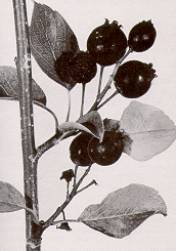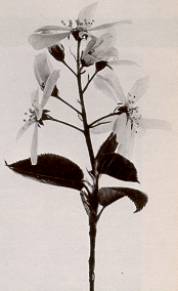
The
Hidden Orchard

It may not be in rows but it is right
out in the open, throughout our cities, town, and countryside, across every
province in Canada. The shrubs or
small trees that make up this orchard have been planted as an ornamental for
generations. It is a native plant
of Canada, tolerant of severe cold, resistant to pests, displaying showy white
flowers in spring, and brilliant red leaves in the fall, the fruit (small purple
berries) are juicy and sweet. You
can substitute them in any Blueberry recipes with equal, some would argue better
results.
 Landscape architects have included this
plant in parks and gardens at a much higher rate then other plants of its size
due to its many positive qualities. As
a result, it literally seems as if this plant is everywhere.
In fact, Burlington city hall grounds include a number of large examples,
and Spencer Smith Park has two very large specimens of this plant (right at the
steps at the east entrance to the park).
Landscape architects have included this
plant in parks and gardens at a much higher rate then other plants of its size
due to its many positive qualities. As
a result, it literally seems as if this plant is everywhere.
In fact, Burlington city hall grounds include a number of large examples,
and Spencer Smith Park has two very large specimens of this plant (right at the
steps at the east entrance to the park).
 Here is the irony.
The fruit is plentiful as in an orchard, yet few people in Canadian urban
areas know how great the berries are. It
goes unseen as if hidden. Tons of
fruit fall to the ground as people walk by.
The fruit is practically all around and free for the picking.
Service clubs could add picking and selling these berries to their list
of money raising programs. People
could indulge on them on their way to where ever, they just need to pause long
enough to enjoy.
Here is the irony.
The fruit is plentiful as in an orchard, yet few people in Canadian urban
areas know how great the berries are. It
goes unseen as if hidden. Tons of
fruit fall to the ground as people walk by.
The fruit is practically all around and free for the picking.
Service clubs could add picking and selling these berries to their list
of money raising programs. People
could indulge on them on their way to where ever, they just need to pause long
enough to enjoy.
Guessed it yet?
Amelanchier Med (the Latin name). You may know this plant by a few names,[1]
Serviceberry, Juneberry, Allegheny Serviceberry, Downy Serviceberry,
Saskatoon-berry, or Mountain Juneberry. And
you thought they were bird berries? Well,
birds like them too, they are delicious!